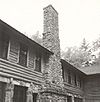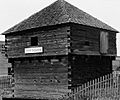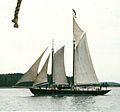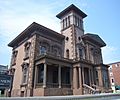List of National Historic Landmarks in Maine facts for kids
The United States has special places called National Historic Landmarks. These are important buildings, areas, objects, or sites that tell a big part of America's story. They are chosen by the National Park Service because they are very important to the history of the country.
The state of Maine has 44 of these amazing landmarks! They show off Maine's history with the sea, famous writers, old discoveries, religious places, and many other interesting things.
One landmark in Maine, called Wickyup, lost its special title after it was sadly destroyed by fire. Another, the schooner Roseway, moved to Boston, Massachusetts. Maine is also home to the St. Croix Island International Historic Site. This place is important for both U.S. and Canadian history because it was where the French first settled in Acadia way back in 1603!
Maine's National Historic Landmarks
| Landmark name | Image | Date designated | Location | County | Description | |
|---|---|---|---|---|---|---|
| 1 | American Eagle |
(#91002064) |
Rockland 44°06′41″N 69°06′12″W / 44.11148°N 69.1032°W |
Knox | This is one of the last two-masted schooners ever built in Gloucester, Massachusetts. Today, it takes people on fun boat trips. | |
| 2 | James G. Blaine House |
(#66000024) |
Augusta 44°18′28″N 69°46′53″W / 44.3078°N 69.7814°W |
Kennebec | Built in 1833 for a ship's captain, this house has been the official residence of Maine's governor since 1919. | |
| 3 | Bowdoin |
(#80000411) |
Castine 44°23′12″N 68°47′48″W / 44.3867°N 68.7967°W |
Hancock | This schooner was specially built in 1921 for exploring the Arctic. Now, it's used as a training ship. | |
| 4 | Camden Amphitheatre and Public Library |
(#13000285) |
Camden 44°12′40″N 69°03′52″W / 44.211°N 69.0645°W |
Knox | The Camden Library building was designed in the 1920s. Its beautiful outdoor area, including an amphitheatre, was created by famous landscape architect Fletcher Steele. | |
| 5 | Parker Cleaveland House |
(#00000702) |
Brunswick 43°54′38″N 69°57′36″W / 43.9106°N 69.9599°W |
Cumberland | This was the home of Parker Cleaveland, who was known as the "Father of American Mineralogy." He studied rocks and minerals here from 1806 to 1858. | |
| 6 | Cushnoc Archeological Site |
(#89001703) |
Augusta 44°18′54″N 69°46′16″W / 44.315°N 69.771°W |
Kennebec | Near Fort Western, this site holds the remains of a trading post from the 1600s, built by the Plymouth Colony. | |
| 7 | Neal Dow House |
(#73000236) |
Portland 43°39′11″N 70°16′12″W / 43.6531°N 70.27°W |
Cumberland | This was the home of Neal S. Dow, who was the mayor of Portland and later ran for U.S. president in 1880. | |
| 8 | Eagle Island |
(#71000069) |
South of Harpswell on Eagle Island 43°42′41″N 70°03′23″W / 43.711389°N 70.056389°W |
Cumberland | This island was the home of Arctic explorer Admiral Robert Peary for many years. It is now a state park. | |
| 9 | Fort Halifax |
(#68000015) |
Winslow 44°32′05″N 69°37′47″W / 44.5347°N 69.6297°W |
Kennebec | This fort from the 1750s has the oldest blockhouse (a small, strong fort) still standing in the United States. | |
| 10 | Fort Kent |
(#69000005) |
Fort Kent 47°15′09″N 68°35′27″W / 47.2525°N 68.5908°W |
Aroostook | This is the only fort left from the Aroostook War, a time when Maine and New Brunswick had a peaceful disagreement over their border. | |
| 11 | Fort Knox |
(#69000023) |
Prospect 44°33′58″N 68°48′09″W / 44.5661°N 68.8025°W |
Waldo | Built between 1844 and 1869, this large granite fort was made after border problems in the 1830s. It's a great example of a mid-19th-century fort. | |
| 12 | Fort Western |
(#69000009) |
Augusta 44°18′59″N 69°46′16″W / 44.3164°N 69.7711°W |
Kennebec | Built in 1754 when this area was a frontier, this is the oldest wooden fort in the United States. | |
| 13 | Daniel Coit Gilman Summer House |
(#66000093) |
Northeast Harbor 44°17′30″N 68°16′56″W / 44.2917°N 68.2822°W |
Hancock | This was the summer home of Daniel Coit Gilman, who was the president of Johns Hopkins University. He helped create advanced education in the U.S. | |
| 14 | Governor's House (Maine) |
(#74000319) |
Togus 44°16′48″N 69°42′08″W / 44.28°N 69.7022°W |
Kennebec | This building from 1869 was part of the very first home for veterans (old soldiers) in the United States. | |
| 15 | Grace Bailey |
(#90001466) |
Camden 44°12′36″N 69°03′50″W / 44.21°N 69.0639°W |
Knox | This two-masted schooner was built in 1882 to carry goods along the coast. Now, it's a popular windjammer for tourists. | |
| 16 | Hamilton House |
(#70000082) |
South Berwick 43°12′46″N 70°48′56″W / 43.2128°N 70.8156°W |
York | This house from 1788 was featured in a novel by local author Sarah Orne Jewett. She also helped save it from being torn down. | |
| 17 | Harpswell Meetinghouse |
(#68000014) |
Harpswell Center 43°47′56″N 69°59′15″W / 43.7989°N 69.9875°W |
Cumberland | This building is a great example of a wooden church from the mid-1700s. It was also used for town meetings. | |
| 18 | Winslow Homer Studio |
(#66000092) |
Scarborough 43°31′42″N 70°19′13″W / 43.5283°N 70.3203°W |
Cumberland | This remodeled building was the art studio of famous artist Winslow Homer from 1884 until he passed away. You can visit it today through the Portland Museum of Art. | |
| 19 | Isaac H. Evans |
(#91002061) |
Rockland 44°06′32″N 69°06′32″W / 44.1089°N 69.1089°W |
Knox | This 1886 schooner was built to catch oysters. Now, it's part of Maine's windjammer fleet, taking tourists on sailing trips. | |
| 20 | J. & E. Riggin |
(#91002062) |
Rockland 44°06′26″N 69°06′23″W / 44.1072°N 69.1064°W |
Knox | This 1920s schooner was one of the last ships built for oyster fishing. It was later changed back to a sailing ship and is now a Maine windjammer. | |
| 21 | Sarah Orne Jewett House |
(#73000248) |
South Berwick 43°14′05″N 70°48′13″W / 43.2347°N 70.8036°W |
York | This house from 1774 was the long-time home of author Sarah Orne Jewett. Her family later gave the house to a group that preserves old buildings, now called Historic New England. | |
| 22 | Kennebec Arsenal |
(#70000046) |
Augusta 44°18′30″N 69°46′10″W / 44.3083°N 69.7694°W |
Kennebec | This place was a storage area for weapons built in the 1830s during border disagreements. It's the best example of a military base from that time. | |
| 23 | Lady Pepperrell House |
(#66000094) |
Kittery Point 43°04′53″N 70°43′00″W / 43.08139°N 70.7167°W |
York | This grand mansion was built in the early 1760s by the wife of Sir William Pepperrell, a very important businessman and politician. | |
| 24 | Lewis R. French |
(#82005263) |
Camden Harbor, Camden 44°12′37″N 69°03′46″W / 44.2104°N 69.0627°W |
Knox | This 1871 schooner is the oldest known schooner built in Maine. It mostly carried cargo and now takes tourists on windjammer cruises. | |
| 25 | McIntire Garrison House |
(#68000017) |
York 43°10′05″N 70°42′49″W / 43.168055555555554°N 70.71361111111112°W |
York | This house, built in the late 1600s or early 1700s, is a great example of how log houses were built back then. | |
| 26 | McLellan-Sweat Mansion |
(#70000073) |
Portland 43°39′12″N 70°15′45″W / 43.6533°N 70.2625°W |
Cumberland | Built in 1800 for a shipping merchant, this mansion has been part of the Portland Museum of Art for many years. | |
| 27 | Mercantile |
(#82005265) |
Camden 44°12′36″N 69°03′46″W / 44.21°N 69.0628°W |
Knox | This 1916 schooner was used to carry goods until the 1940s. It has been fixed up and is now part of Maine's windjammer fleet. | |
| 28 | Morse-Libby Mansion |
(#70000074) |
Portland 43°39′05″N 70°15′39″W / 43.6515°N 70.2607°W |
Cumberland | This mansion, built in 1860 as a summer home, is one of the best and most original examples of a large Italian-style brick house in the U.S. Locals call it the Victoria Mansion. | |
| 29 | Nickels-Sortwell House |
(#70000078) |
Wiscasset 44°00′10″N 69°39′56″W / 44.0029°N 69.6656°W |
Lincoln | Built in 1807 for a ship's captain, this house was used for different things before becoming a summer home. Now, it's a museum run by Historic New England. | |
| 30 | Norridgewock Archeological District |
(#93000606) |
Madison 44°45′54″N 69°52′59″W / 44.765°N 69.8831°W |
Somerset | This area holds the remains of the village of the Norridgewock Abenaki people, who were the native inhabitants of central Maine. | |
| 31 | Old York Gaol |
(#68000016) |
York 43°08′38″N 70°39′06″W / 43.14375°N 70.6517°W |
York | This building was used as a jail from 1719 to 1879. It was built using parts of an even older jail. Today, it's a local museum. | |
| 32 | Olson House |
(#93001114) |
Cushing 43°58′54″N 69°16′07″W / 43.9817°N 69.2686°W |
Knox | Famous artist Andrew Wyeth spent 30 summers at this house and is buried nearby. The house appears in many of his paintings, including Christina's World. | |
| 33 | Pemaquid Archeological Site |
(#69000022) |
Bristol 43°52′41″N 69°31′17″W / 43.8781°N 69.52139°W |
Lincoln | This site on Maine's central coast includes old forts and colonial towns that date back to before the 1690s. | |
| 34 | Pentagoet Archeological District |
(#93000603) |
Castine 44°23′04″N 68°48′12″W / 44.38458°N 68.8033°W |
Hancock | This old site shows a long history of colonial times, starting in the early 1600s. It was a place for trade and also for conflicts between French and English settlers. | |
| 35 | Perkins Homestead |
(#14000919) |
Newcastle 44°00′19″N 69°33′27″W / 44.0052°N 69.5575°W |
Lincoln | This was the family home and summer residence of Frances Perkins, a very important Secretary of Labor. | |
| 36 | Portland Observatory |
(#73000122) |
Portland 43°39′55″N 70°14′54″W / 43.6653°N 70.2483°W |
Cumberland | This wooden tower from 1807 is the oldest maritime signal tower in the U.S. It could send and receive messages to ships entering Portland Harbor. | |
| 37 | Thomas B. Reed House |
(#73000239) |
Portland 43°39′15″N 70°16′03″W / 43.65417°N 70.2675°W |
Cumberland | This house was built in 1888 for Thomas Brackett Reed (1839–1902), who was the Speaker of the U.S. House of Representatives. | |
| 38 | Edwin Arlington Robinson House |
(#71000070) |
Gardiner 44°13′20″N 69°46′25″W / 44.2222°N 69.7736°W |
Kennebec | This was the home of Edwin Arlington Robinson, a poet who won the Pulitzer Prize. | |
| 39 | Sabbathday Lake Shaker Village |
(#74000318) |
New Gloucester 43°59′22″N 70°21′59″W / 43.9894°N 70.3664°W |
Cumberland | Started in 1783, this is the last active Shaker community in the United States. You can see many Shaker tools and furniture here. | |
| 40 | Stephen Taber |
(#84001386) |
Rockland 44°06′20″N 69°06′25″W / 44.1056°N 69.1069°W |
Knox | This two-masted schooner from 1871 is now a windjammer. It's the oldest ship of its kind that has been used continuously for so long. | |
| 41 | Harriet Beecher Stowe House |
(#66000091) |
Brunswick 43°54′46″N 69°57′39″W / 43.9128°N 69.9608°W |
Cumberland | This house was home to writer Harriet Beecher Stowe, who wrote the famous book Uncle Tom's Cabin here. | |
| 42 | Tate House |
(#70000072) |
Stroudwater 43°39′27″N 70°18′45″W / 43.6574°N 70.3124°W |
Cumberland | This house from the 1750s was built for George Tate, who helped the British Navy get wood for ship masts. It's the only house from before the American Revolution in the Portland area that you can visit. | |
| 43 | Victory Chimes |
(#93000637) |
Rockland 44°06′41″N 69°06′14″W / 44.11139°N 69.1039°W |
Knox | This cargo schooner was built in Delaware in 1900. Now, it's part of Maine's windjammer fleet. The ship on Maine's State Quarter looks like her! | |
| 44 | Wadsworth-Longfellow House |
(#66000090) |
Portland 43°39′25″N 70°15′37″W / 43.656944°N 70.26028°W |
Cumberland | This was the home of General Peleg Wadsworth from the Revolutionary War. It was also the childhood home of his grandson, the famous poet Henry Wadsworth Longfellow. |
Former Landmarks in Maine
Some places were once National Historic Landmarks in Maine but are no longer on the list.
| # | Landmark name | Image | Date designated | Date withdrawn/moved | Locality | County | Description |
|---|---|---|---|---|---|---|---|
| 1 | Wickyup (Richard E. Byrd House) |  |
August 24, 1970 | March 5, 1986 | East Sullivan | Hancock | This house was the summer home of pioneer aviator and explorer Admiral Richard E. Byrd from 1937 until his death in 1957. He planned three trips to Antarctica here and wrote books. Wickyup was destroyed by fire in 1984. |
| 2 | Roseway |  |
September 25, 1997 | 2014 | Camden 44°12′36″N 69°03′46″W / 44.21°N 69.06278°W |
Knox | Launched in 1925 in Essex, Massachusetts, this wooden gaff-rigged schooner was mainly used for racing. It is now located in Boston, Massachusetts. |
See also












































